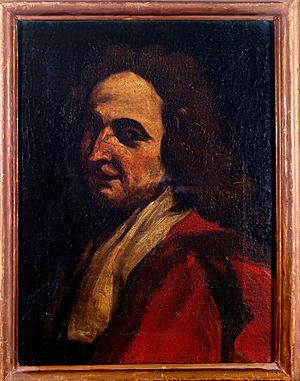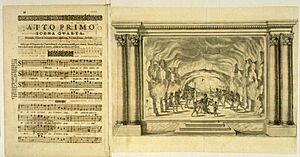Stefano Landi facts for kids
Stefano Landi was an Italian composer and teacher. He lived during the early Baroque period, a style of music popular from about 1600 to 1750. Landi was part of the Roman School, a group of composers in Rome. He was important because he wrote some of the first operas. An opera is a play where most of the words are sung. His opera, Il Sant'Alessio, was the first one based on a real historical story. Stefano Landi was born in 1587 and died in 1639.
Contents
Life of Stefano Landi
Stefano Landi was born in Rome, which was the capital of the Papal States at that time.
Early Music Training
In 1595, when he was a boy, Landi joined the Collegio Germanico in Rome. He sang there as a boy soprano. He might have learned music from a teacher named Asprilio Pacelli. In 1599, Landi took minor orders, which means he joined a religious group. He then started studying at the Seminario Romano in 1602.
Records from the Seminary show that Landi was a composer and director. In 1607, he directed a play for Carnival. By 1611, he was working as an organist and singer. He also became the maestro di cappella (music director) at a church called S Maria della Consolazione in 1614. Another music director, Agostino Agazzari, might have been one of Landi's teachers too.
Moving to Northern Italy
Around 1618, Landi moved to northern Italy. He published a book of madrigals (a type of song) in Venice. It seems he got a job as a music director in Padua. While in Padua, he wrote his first opera, La morte d'Orfeo. This opera was probably performed for a wedding celebration.
His time in Padua and Venice was very important for his music style. There, he learned from the Venetian School composers. Their music was more modern and exciting than the older style often used in Rome.
Return to Rome
In 1620, Landi went back to Rome. He stayed there for the rest of his life. In Rome, he worked for important families who supported artists. These included the Borghese family, Cardinal Maurizio of Savoy, and especially the Barberini family. The Barberini family was his main employer in the 1620s and 1630s.
In 1629, he also joined the papal choir, which was the Pope's own choir. For the Barberini family, Landi wrote his most famous work, Sant'Alessio, in 1632. This opera was used to open the Teatro delle Quattro Fontane, a new theater. During this time, he wrote a lot of music. He composed masses, arias (songs), and responsories (church music).
He often used the seconda pratica style, which was a newer Baroque style. Some older musicians did not like this. They thought the prima pratica style, like the music of Palestrina, was better for church music.
After 1636, Landi started to get sick. He died in Rome in 1639 and was buried at a church called Santa Maria in Vallicella.
Landi's Music and Impact
Stefano Landi's music was interesting because his non-religious songs were often more traditional. For example, his first book of madrigals for five voices sounded a lot like songs from the late 1500s.
Church Music
Landi wrote only two masses (church services set to music). These were in a simple, older style. This style was encouraged by the Counter-Reformation, a movement in the Catholic Church. However, for some of his motets (short religious songs), and his settings of the Magnificat and Vespers psalms, he used the Venetian concertato style. This style used different groups of singers and instruments. He probably learned this from his years in northern Italy.
Il Sant'Alessio Opera
His most famous work is the opera Il Sant'Alessio. It tells the story of Saint Alexis, who lived in the fifth century. This opera is very important in early Baroque music. It was the first opera to be based on a historical person. It also tried to show the saint's inner thoughts and feelings, which was new for opera. The opera also has funny parts that show life in Rome in the 1600s.
The part of Sant'Alessio himself is very high for a singer. When it was first performed, half of the singers were from the papal choir. The orchestra for the opera was very modern for its time. It did not use old instruments like viols. Instead, it used violins, cellos, harps, lutes, theorbos, and harpsichords.
The opera also has short musical pieces at the beginning called canzonas. These were like the first overtures in opera history. Sant'Alessio mixed dances and funny scenes with serious songs (arias) and spoken parts (recitatives). This made the opera very exciting and popular. It was one of the first plays to successfully mix both monodic (one voice with music) and polyphonic (many voices at once) styles.
Images for kids
See also
 In Spanish: Stefano Landi para niños
In Spanish: Stefano Landi para niños




